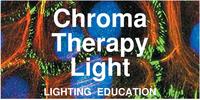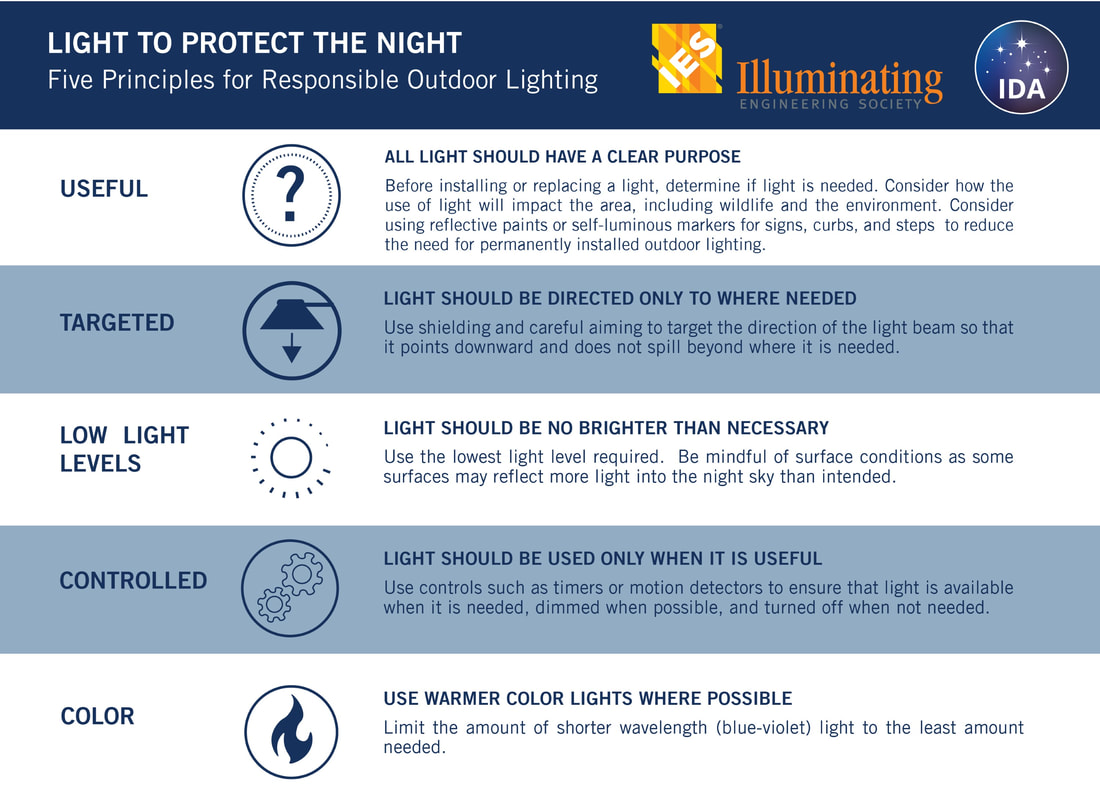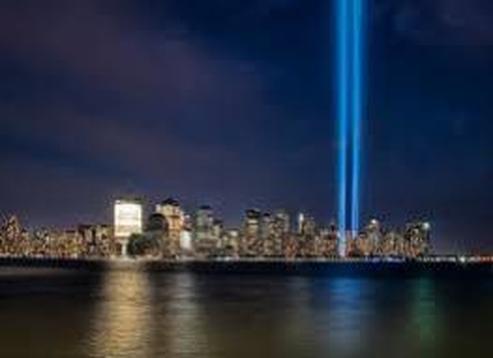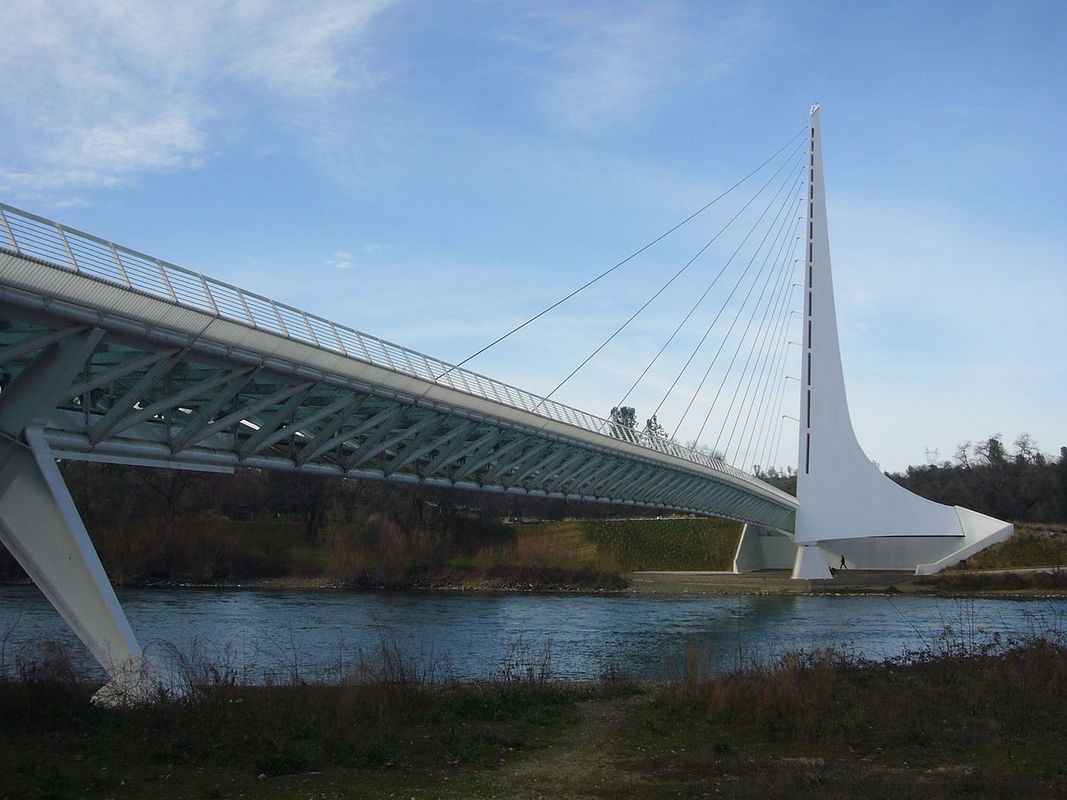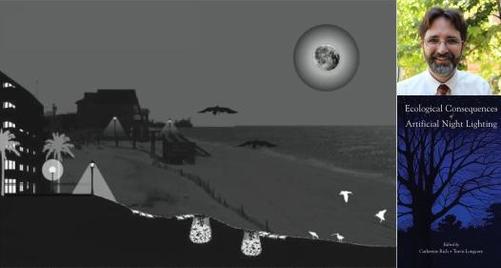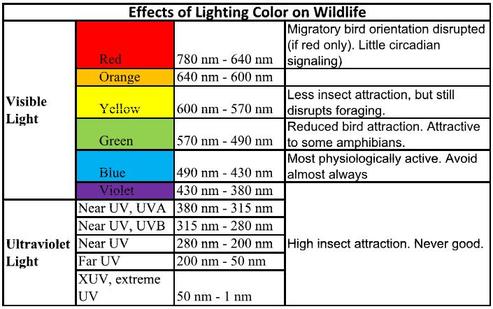At night, put light where it is needed, keep it warm, keep it dim.Night Lighting Ecology - Learning Objectives
When we use carefully aimed, dimmer lights - instead of excessively bright, glaring ones - we can see better, maybe even see the stars. Balance and restraint is the key to most things in life, and restraint also applies to lighting, especially in our night sky.
Visit my Dark Sky page at TOlighting.com Five Principles for Responsible Outdoor Lighting
April 16, 2020 IDA and IES announce strategic collaboration to advance quality lighting to reduce light pollution. “By following these simple principles, electric lighting at night can be beautiful, healthy, and functional. These principles work together to reduce light pollution, save energy and money, and minimize wildlife disruption,” said Ruskin Hartley, Executive Director of IDA.
“Following these Principles is not difficult and results in more effective and comfortable lighting installations.”said Brian Liebel, Director of Standards and Research for the IES. [1] This link is to a PDF on how to light your residence with Dark Sky best practice: https://idsw.darksky.org/wp-content/uploads/2020/04/Dark-Sky-Friendly-Home-Lighting-program-guide_Print.pdf
Notes from IES Mission Meeting - Feb 19, 2016 - Light Pollution and the Ecological Consequences of Artificial Night Lighting by Dr. Travis Longcore
High-intensity urban light installation dramatically alters nocturnal bird migration [2]Birds are attracted to light.
High-intensity artificial lights attract birds and disrupts their migration patterns. Birds are observed circling lighting and vocalizing, wasting energy otherwise spent on migration. Birds become disoriented, exhausted, and many die. In a recently published study with data collected between 2008 and 2016, during Tribute in Light, up to 20 times the normal density of birds have been observed, they disperse, when the lights are shut off for 20 minutes. Here is a link to the study, High-intensity urban light installation dramatically alters nocturnal bird migration, is provided in the footnotes. [2] and an article in International Dark Sky Association newsletter. [3] Bridges with vanity lighting scare fish from migrating.
In Redding, California, there is a foot bridge named Sundial Bridge. One study shows that during fish migration season, the numbers of fish passing under the illuminated bridge were staggeringly low compared to before the lighting of the bridge.
http://archive.redding.com/news/state-wildlife-officials-say-sundial-bridge-lighting-may-be-hurting-salmon-ep-361600259-354020541.html/ The City of Redding has posted this page, https://www.cityofredding.org/departments/parks-and-recreation/light-the-sundial Seals have become a charged problem, Canwest News Service, Published: Sunday, April 20, 2008 ... Even under perfect conditions, only one per cent of Chinook salmon smolts that swim down the Puntledge and into the Strait of Georgia return three or four years later to spawn. The presence of crafty, voracious harbour seals makes their chances of survival even worse. According to Ottawa, a herd of determined seals has been trolling the Puntledge for years, eating up almost every baby summer Chinook in sight. Some 50 seals have learned to swim up the Puntledge and hide in the shadows under a bridge that serves the city of Courtenay. Streetlights that line the city's Fifth Street bridge illuminate the unsuspecting smolts as they move downstream at night; the seals set their sights, open their mouths and feast. [4] |
Ecological Consequences of Artificial Night Lighting
Ecological Consequences of Artificial Night Lighting
By Catherine Rich and Travis Longcore While certain ecological problems associated with artificial night lighting are widely known-for instance, the disorientation of sea turtle hatchlings by beachfront lighting-the vast range of influences on all types of animals and plants is only beginning to be recognized. From nest choice and breeding success of birds to behavioral and physiological changes in salamanders, many organisms are seriously affected by human alterations in natural patterns of light and dark. Ecological Consequences of Artificial Night Lighting is the first book to consider the environmental effects of the intentional illumination of the night. It brings together leading scientists from around the world to review the state of knowledge on the subject and to describe specific effects that have been observed across a full range of taxonomic groups, including mammals, birds, reptiles and amphibians, fishes, invertebrates, and plants. Ecological Consequences of Artificial Night Lighting provides a scientific basis to begin addressing the challenge of conserving the nighttime environment. It cogently demonstrates the vital importance of this until-now neglected topic and is an essential new work for conservation planners, researchers, and anyone concerned with human impacts on the natural world. Artificial Light Affects Zooplankton in Arctic"... Light is an important cue for many biological processes. The study notes, “the zooplankton community is intimately connected to the ambient light regime.” In zooplankton communities, light induces cyclical patterns of vertical movements called diel vertical migrations (DVMs). According to the authors of this study, “The DVM of zooplankton is the most widespread and synchronized movement of biomass on the planet and thus is one of the most important factors to consider for understanding marine food-web interactions and ecosystem structures.”..."
http://darksky.org/artificial-light-affects-zooplankton-in-arctic/ [5] How to support Dark Sky?
Become a citizen-scientists to measure & submit their night sky brightness observations.https://www.globeatnight.org/ In 2017 citizen scientists from around the world contributed 15,382 data points. Globe at Night is a program of the National Optical Astronomy Observatory, the national center for ground-based nighttime astronomy in the United States, operated by the Association of Universities for Research in Astronomy (AURA), under cooperative agreement with the National Science Foundation.
https://www.globeatnight.org/ Be sure to read the article about Davis LED Retrofit Zombie Lights, By James Benya
European Dark Sky Places Conference
20-22 September 2017, Gatehouse of Fleet, Dumfries & Galloway, Scotland experts gathered for Europe's first dark sky conference.
"...The stars are not just used by us in lots of different ways but they are also used by migrating birds and everything else to actually navigate by. Light pollution is causing all sorts of health issues and there is lots of research out there saying that we are only just beginning to see the long-term effects of that. He said there were also environmental issues related to energy use." Forest Enterprise Scotland visitor services manager Keith Muir said a lot had been achieved since the park reached dark sky status. [6]
Footnotes
Photo Credit
|
- Home
-
- CHROMA Topics
- Color Spectrum - Light is Energy
- Color in Light
- Color in Nature
- Color in Paint
- Why does paint fade?
- Color Names & Meanings
- Color Phenomena
- Color Perception is Individual
- Color In Fashion
- Color for your home
- Color in Space
- Color Blindness
- Color Blind Interview
- Synesthesia
- Synesthete Deborah Borrowdale-Cox
- Synesthete Stephen Orr, BH&G Editor
-
- Circadian & THERAPY Topics
- Circadian Explained
- Circadian Ganglion Cells
- Circadian Melatonin
- Circadian Animals
- Circadian Research
- Autism & Lighting for the Spectrum
- Blue Light Dimming Apps
- Red Night Lights
- Vitamin D & Light
- SAD - Seasonal Affective Disorder
- Alzheimers and Light Therapy
- Photosensitivity - Light Sensitive Drugs
- Red Light Therapy
- Sleep & Lighting
- Dreams and Second Sleep
- NASA - Lighting in Space & Undersea
- Jet Lag
- Sunglasses
- Chakras
- Crystals, Minerals, & Gemstones
-
- LIGHTing Design Topics
- UV Germicidal Disinfection Light
- LED Lighting Facts Card
- CRI - Color Rendering Index
- LED TM-30
- LED Kelvin Color
- LED LPW
- LED Flicker
- LED Glare
- OLED - Organic LED
- Human Centric Lighting
- Lighting with Daylighting
- Lighting for Healthy Buildings & Zero Net Energy
- Lighting for Healthcare
- Lighting for Horticulture
- Lighting for Hospitality & LED Retrofits
- Lighting for Museums
- Lighting for Seniors & Low Vision
- Lighting Design Tips & Codes
- Parking Lot Lighting
- Solar Lighting for Humanity & World Health
- Davis Insectary Garden
- Santa Barbara Mesa Insectary Garden
- Home
-
- CHROMA Topics
- Color Spectrum - Light is Energy
- Color in Light
- Color in Nature
- Color in Paint
- Why does paint fade?
- Color Names & Meanings
- Color Phenomena
- Color Perception is Individual
- Color In Fashion
- Color for your home
- Color in Space
- Color Blindness
- Color Blind Interview
- Synesthesia
- Synesthete Deborah Borrowdale-Cox
- Synesthete Stephen Orr, BH&G Editor
-
- Circadian & THERAPY Topics
- Circadian Explained
- Circadian Ganglion Cells
- Circadian Melatonin
- Circadian Animals
- Circadian Research
- Autism & Lighting for the Spectrum
- Blue Light Dimming Apps
- Red Night Lights
- Vitamin D & Light
- SAD - Seasonal Affective Disorder
- Alzheimers and Light Therapy
- Photosensitivity - Light Sensitive Drugs
- Red Light Therapy
- Sleep & Lighting
- Dreams and Second Sleep
- NASA - Lighting in Space & Undersea
- Jet Lag
- Sunglasses
- Chakras
- Crystals, Minerals, & Gemstones
-
- LIGHTing Design Topics
- UV Germicidal Disinfection Light
- LED Lighting Facts Card
- CRI - Color Rendering Index
- LED TM-30
- LED Kelvin Color
- LED LPW
- LED Flicker
- LED Glare
- OLED - Organic LED
- Human Centric Lighting
- Lighting with Daylighting
- Lighting for Healthy Buildings & Zero Net Energy
- Lighting for Healthcare
- Lighting for Horticulture
- Lighting for Hospitality & LED Retrofits
- Lighting for Museums
- Lighting for Seniors & Low Vision
- Lighting Design Tips & Codes
- Parking Lot Lighting
- Solar Lighting for Humanity & World Health
- Davis Insectary Garden
- Santa Barbara Mesa Insectary Garden
